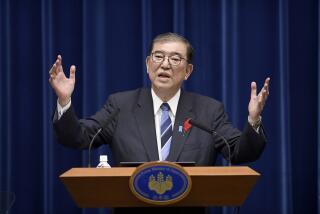Stage Is Set for Japan Premier to Call Election
- Share via
TOKYO — Riding high on his success in ending a damaging battle with Okinawa, Prime Minister Ryutaro Hashimoto on Thursday set the stage to hold a general election Oct. 20.
The widely anticipated election for the lower house of parliament will be the first opportunity in more than three tumultuous political years for voters to weigh in on where Japan is headed. The nation is on its fourth prime minister and its third coalition government since the last election in 1993.
The upcoming vote is the first test of a new electoral system that includes stiffer campaign spending limits, along with a new system for electing 300 members of the lower house of parliament from enlarged districts and allocating the remaining 200 seats among the parties by proportional representation.
Whether this package will lead to real political reform is unknown, however. Political analysts say the biggest beneficiary may turn out to be the Liberal Democratic Party, or LDP, which has dominated Japanese politics since World War II.
Japan now has six major political parties, including the new Democratic Party, a promising contender that is still in the process of being formed by rising political star Yukio Hatoyama and popular Health and Welfare Minister Naoto Kan.
The party picture is now so confusing that few Japanese have a clear understanding of what the parties stand for--or even which politicians belong to what party.
Many political analysts are giving Hashimoto a better-than-even chance of holding on to his job as prime minister.
His LDP now leads the polls--though it is running a distant second to “undecided”--and analysts say there is an outside chance that the LDP could win a majority of the 500 seats created in the new parliament, returning Japan to one-party rule.
A more likely scenario, analysts say, is that the LDP will win a strong plurality, setting off another postelection blitz of coalition-building.
Party leaders have already begun an intricate mating dance that, in keeping with Japanese political tradition, appears to have more to do with personal relationships and political considerations than with ideology.
Technically, Hashimoto has not yet called elections or set the date.
However, on Thursday he met with the leaders of the Social Democratic Party and New Party Harbinger, his ruling coalition partners, and won agreement to convene an extraordinary session of parliament Sept. 27.
Social Democratic leader Tomiichi Murayama and Shoichi Ide, leader of New Party Harbinger, both of whom want to delay the elections as long as possible, opposed Hashimoto’s reported plan to dissolve the lower house as soon as it convenes.
Murayama said the prime minister should at least report on the recent breakthrough with Okinawa, which has dropped a yearlong legal battle to try to prevent the national government from renewing leases on land used for U.S. military bases.
The United States and Japan are now discussing a new plan to minimize the impact of military air traffic on Okinawans by building a floating offshore heliport.
Despite the formal opposition to early elections, Murayama also reported after the meeting with Hashimoto that “we have confirmed our agreement to keep the three-party coalition format.”
That remark was interpreted to mean that the Socialists, who are expected to perform so dismally that they may all but cease to exist after the next election, will probably not fight Hashimoto over the election date.
Japanese newspapers have for weeks been reporting leaks from politicians putting the date of the election as Oct. 20.
In today’s editions, the major papers reported that Hashimoto has decided to dissolve the extraordinary session of parliament Sept. 27, announce the new elections Oct. 8 and schedule them for Oct. 20.
A Nikkei Shimbun poll this week found 22.4% of those surveyed expected to vote for the LDP, followed by 7.8% for Hatoyama’s new Democratic Party and 6.5% for the opposition New Frontier Party.
Meanwhile, in Washington, the discussion over Okinawa moved a step forward Thursday when the foreign and defense ministers of Japan and the United States agreed to study the possibility of building a huge offshore platform to serve as a base for helicopters that must be moved from Futenma Marine base, which the United States has agreed in principle to close.
Defense Secretary William J. Perry said the offshore facility, similar to a giant oil-drilling platform, was one of three plans for helicopter bases that will be studied by a U.S.-Japan task force. The others are Camp Schwab, a Marine training facility on the less densely populated north side of Okinawa, and Kadena Air Base in Okinawa.
But he said the offshore plan “is very appealing to both Japanese and Americans, both of whom are very strong in technology. The visionary in me hopes this floating offshore facility will be the solution to the problem.”
Perry and Secretary of State Warren Christopher met for almost five hours with Japanese Foreign Minister Yukihiko Ikeda and Defense Minister Hideo Usui.
Hashimoto endorsed the floating heliport plan in a speech in Okinawa earlier this week.
Times staff writer Norman Kempster in Washington contributed to this report.
More to Read
Sign up for Essential California
The most important California stories and recommendations in your inbox every morning.
You may occasionally receive promotional content from the Los Angeles Times.













